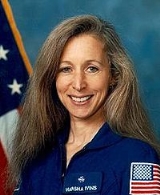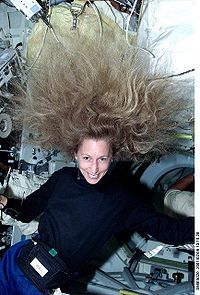
Marsha Ivins
Encyclopedia
Marsha Sue Ivins is a former American
astronaut
and a veteran of five space shuttle
missions.
from the University of Colorado at Boulder
in 1973 and went to work for NASA
's Johnson Space Center. She worked mainly on orbiter displays and controls before being assigned as a flight engineer
in 1980 and co-pilot on NASA administrative aircraft. In 1984, Ivins was selected as an astronaut candidate. She has flown aboard missions STS-32
(1990), STS-46
(1992), STS-62
(1994), STS-81
(1997), and STS-98
(2001).
Ivins retired from NASA on December 31, 2010.
 STS-32 (January 9–20, 1990) launched from the Kennedy Space Center, Florida, on an eleven-day flight, during which crew members on board the Orbiter Columbia successfully deployed a Syncom satellite, and retrieved the 21,400-pound Long Duration Exposure Facility (LDEF). Mission duration was 261 hours, 1 minute, and 38 seconds. Following 173 orbits of the Earth and 4.5 million miles, Columbia returned with a night landing at Edwards Air Force Base, California.
STS-32 (January 9–20, 1990) launched from the Kennedy Space Center, Florida, on an eleven-day flight, during which crew members on board the Orbiter Columbia successfully deployed a Syncom satellite, and retrieved the 21,400-pound Long Duration Exposure Facility (LDEF). Mission duration was 261 hours, 1 minute, and 38 seconds. Following 173 orbits of the Earth and 4.5 million miles, Columbia returned with a night landing at Edwards Air Force Base, California.
STS-46 (July 31-August 8, 1992) was an 8-day mission, during which crew members deployed the EURECA (European Retrievable Carrier) satellite, and conducted the first Tethered Satellite System (TSS) test flight. Mission duration was 191 hours, 16 minutes, and 7 seconds. Space Shuttle Atlantis and her crew launched and landed at the Kennedy Space Center, Florida, completing 126 orbits of the Earth in 3.35 million miles.
STS-62 (March 4–18, 1994) was a 14-day mission for the United States Microgravity Payload (USMP) 2 and Office of Aeronautics and Space Technology (OAST) 2 payloads. These payloads studied the effects of microgravity on materials sciences and other space flight technologies. Other experiments on board included demonstration of advanced teleoperator tasks using the remote manipulator system, protein crystal growth, and dynamic behavior of space structures. Mission duration was 312 hours, 23 minutes, and 16 seconds. Space Shuttle Columbia launched and landed at the Kennedy Space Center, Florida, completing 224 orbits in 5.82 million miles.
STS-81 Atlantis (January 12–22, 1997) was a 10-day mission, the fifth to dock with Russia’s Space Station Mir, and the second to exchange U.S. astronauts. The mission also carried the Spacehab double module providing additional middeck locker space for secondary experiments. In five days of docked operations more than three tons of food, water, experiment equipment and samples were moved back and forth between the two spacecraft. Following 160 orbits of the Earth the STS-81 mission concluded with a landing on Kennedy Space Center’s Runway 33 ending a 3.9 million mile journey. Mission duration was 244 hours, 56 minutes.
STS-98 Atlantis (February 7–20, 2001) continued the task of building and enhancing the International Space Station by delivering the U.S. laboratory module Destiny. The Shuttle spent seven days docked to the station while Destiny was attached and three spacewalks were conducted to complete its assembly. The crew also relocated a docking port, and delivered supplies and equipment to the resident Expedition-1 crew. Space Shuttle Atlantis returned to land at Edwards Air Force Base, California traveling 5.3 million miles in 203 orbits. Mission duration was 12 days, 21 hours, 20 minutes.
United States
The United States of America is a federal constitutional republic comprising fifty states and a federal district...
astronaut
Astronaut
An astronaut or cosmonaut is a person trained by a human spaceflight program to command, pilot, or serve as a crew member of a spacecraft....
and a veteran of five space shuttle
Space Shuttle
The Space Shuttle was a manned orbital rocket and spacecraft system operated by NASA on 135 missions from 1981 to 2011. The system combined rocket launch, orbital spacecraft, and re-entry spaceplane with modular add-ons...
missions.
Career
Ivins, born in Baltimore, Maryland, earned a degree in aerospace engineeringAerospace engineering
Aerospace engineering is the primary branch of engineering concerned with the design, construction and science of aircraft and spacecraft. It is divided into two major and overlapping branches: aeronautical engineering and astronautical engineering...
from the University of Colorado at Boulder
University of Colorado at Boulder
The University of Colorado Boulder is a public research university located in Boulder, Colorado...
in 1973 and went to work for NASA
NASA
The National Aeronautics and Space Administration is the agency of the United States government that is responsible for the nation's civilian space program and for aeronautics and aerospace research...
's Johnson Space Center. She worked mainly on orbiter displays and controls before being assigned as a flight engineer
Flight engineer
Flight engineers work in three types of aircraft: fixed-wing , rotary wing , and space flight .As airplanes became even larger requiring more engines and complex systems to operate, the workload on the two pilots became excessive during certain critical parts of the flight regime, notably takeoffs...
in 1980 and co-pilot on NASA administrative aircraft. In 1984, Ivins was selected as an astronaut candidate. She has flown aboard missions STS-32
STS-32
STS-32 was the 33rd mission of NASA's Space Shuttle program, and the 9th launch of Space Shuttle Columbia. Launching on 9 January 1990, it marked the first time since STS-61-C that Pad A at Kennedy Space Center's Complex 39 was used for a launch; it also marked the first use of Mobile Launcher...
(1990), STS-46
STS-46
STS-46 was a NASA space shuttle mission using orbiter Atlantis and launched on 31 July 1992 at 9:56:48 am EDT.-Crew:-Mission parameters:*Mass:**Orbiter landing with payload: **Payload: *Perigee: *Apogee:...
(1992), STS-62
STS-62
STS-62 was a Space Shuttle program mission flown aboard . The primary payloads were the USMP-02 microgravity experiments package and the OAST-2 engineering and technology payload, both in the orbiter's cargo bay. The two-week mission also featured a number of biomedical experiments focusing on the...
(1994), STS-81
STS-81
STS-81 was a January 1997 Space Shuttle Atlantis mission to the Mir space station.-Crew:-Mission parameters:*Mass: *Perigee: *Apogee: *Inclination: 51.6°*Period: 92.2 min-Fifth Mir docking mission:...
(1997), and STS-98
STS-98
STS-98 was a 2001 Space Shuttle mission to the International Space Station flown by Space Shuttle Atlantis. STS-98 delivered to the station the Destiny Laboratory Module...
(2001).
Ivins retired from NASA on December 31, 2010.
Spaceflight experience

STS-46 (July 31-August 8, 1992) was an 8-day mission, during which crew members deployed the EURECA (European Retrievable Carrier) satellite, and conducted the first Tethered Satellite System (TSS) test flight. Mission duration was 191 hours, 16 minutes, and 7 seconds. Space Shuttle Atlantis and her crew launched and landed at the Kennedy Space Center, Florida, completing 126 orbits of the Earth in 3.35 million miles.
STS-62 (March 4–18, 1994) was a 14-day mission for the United States Microgravity Payload (USMP) 2 and Office of Aeronautics and Space Technology (OAST) 2 payloads. These payloads studied the effects of microgravity on materials sciences and other space flight technologies. Other experiments on board included demonstration of advanced teleoperator tasks using the remote manipulator system, protein crystal growth, and dynamic behavior of space structures. Mission duration was 312 hours, 23 minutes, and 16 seconds. Space Shuttle Columbia launched and landed at the Kennedy Space Center, Florida, completing 224 orbits in 5.82 million miles.
STS-81 Atlantis (January 12–22, 1997) was a 10-day mission, the fifth to dock with Russia’s Space Station Mir, and the second to exchange U.S. astronauts. The mission also carried the Spacehab double module providing additional middeck locker space for secondary experiments. In five days of docked operations more than three tons of food, water, experiment equipment and samples were moved back and forth between the two spacecraft. Following 160 orbits of the Earth the STS-81 mission concluded with a landing on Kennedy Space Center’s Runway 33 ending a 3.9 million mile journey. Mission duration was 244 hours, 56 minutes.
STS-98 Atlantis (February 7–20, 2001) continued the task of building and enhancing the International Space Station by delivering the U.S. laboratory module Destiny. The Shuttle spent seven days docked to the station while Destiny was attached and three spacewalks were conducted to complete its assembly. The crew also relocated a docking port, and delivered supplies and equipment to the resident Expedition-1 crew. Space Shuttle Atlantis returned to land at Edwards Air Force Base, California traveling 5.3 million miles in 203 orbits. Mission duration was 12 days, 21 hours, 20 minutes.

